AMD Athlon II X3 435 CPU Review

Many users believe that the times of dual-core processors are coming to an end. However, so far there haven’t been any inexpensive processors with more than two cores in the market. Today AMD is correcting this: the new triple-core 45 nm CPUs are priced starting at $76!
Today, when Windows 7 OS launch is getting closer by day, AMD is rolling out quite a few new processors. Most of these CPUs are energy-efficient solutions from Athlon II family with two and four computational cores and relatively low clock frequencies, which maximum calculated thermal design power is 45 W. However, a few “standard” 95 W Athlon II X3 400 processors also got in-between their energy-efficient fellows. These are the products that are of primary interest to us today, because so far AMD hasn’t had any triple-core CPUs from Athlon II family, i.e. without L3 cache memory.
The launch of triple-core Athlon II X3 CPUs can hardly be called a big surprise. Being an exclusive manufacturer of processors like that, AMD pays special attention to these solutions. They are great from marketing as well as technical standpoints. On the one hand, Phenom II X3 and Athlon II X3 CPU series provide the company with an extra way of putting partially defective quad-core dies (with the defects in one of the cores) to good use. On the other hand, triple-core AMD processors are positioned as an alternative to dual-core Intel CPUs, which definitely appeals to those users that have already felt the benefits of multi-core architectures.
Since AMD cannot offer high-performance processors that could successfully compete against Intel Nehalem based CPUs, they chose different approach. The company focused on inexpensive solutions that would be superior in functionality to Core 2 Quad, Core 2 Duo and Pentium processors within the same price range. For example, new triple-core Athlon II X3 are targeted for sub-$90 price range, which means that they are competitors to dual-core Pentium processors recently enhanced by Intel by raising their clock frequencies and introducing 1067 MHz bus support.
By launching Athlon II X3 processors AMD concludes the expansion of their product lineup using 45 nm cores. Now the CPUs from this manufacturer start lining up according to very strict hierarchy: top CPUs have L3 cache and are called Phenom II, junior models have no L3 cache and are called Athlon II. However, there are quad-, triple- and dual-core processors in both CPU series.
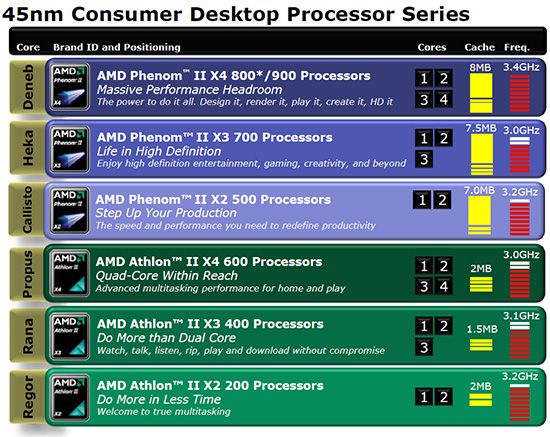
But I have to admit that this great diversity causes certain confusion in terms of market positioning. For example, the manufacturer offers not only new Athlon II X3 400, but also quad-core Athlon II X4 as well as Phenom II X2 and Athlon II X2 in the $90 price range.
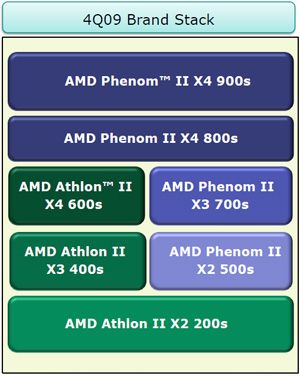
It is sometimes tricky to find your way in this variety of choices that is why today we are going to pay special attention to finding out which AMD processor from the corresponding price range will be a better fit for which type of tasks.
Closer Look at Athlon II X3 435
We received the top AMD Athlon II X3 435 processor to check out the potential of the new triple-core Athlon II X3 CPUs. This processor works at 2.9 GHz clock frequency and sells at the official price of $87. Together with this CPU AMD is launching another similar triple-core processor, Athlon II X3 425, with 2.7 GHz clock frequency and $76 price tag. Frankly speaking, we were a little surprised with these frequencies, because AMD already has one and a half times more expensive Phenom II X3 720 CPU working at 2.8 GHz. The new processors will most likely show similar performance with the latter, even though they don’t have any L3 cache memory.
The complete technical specifications of the CPU that arrived in our lab look as follows:
The reports from diagnostic utilities also do not have any surprises for us. CPU-Z recognizes Athlon II X3 435 correctly as a 45 nm CPU with three cores and no L3 cache memory. According to AMD, this CPU is codenamed Rana.
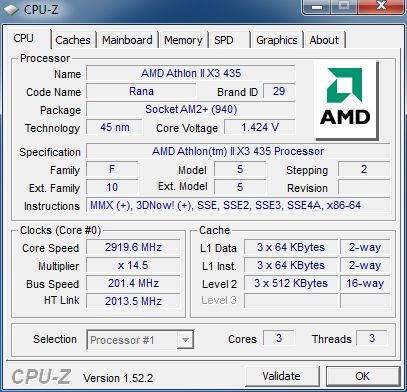
However, I would like to remind you that in reality AMD manufactures only three types of 45 nm semiconductor dies (using GLOBALFOUNDARIES production capacities). They are quad-core Deneb and Propus and dual-core Regor. They are used for Phenom II X4, Athlon II X4 and Athlon II X2 CPUs respectively. The cores for all other AMD processors, including Athlon II X3, are made by disabling some parts of the above listed semiconductor dies, which is successfully used by quite a few computer enthusiasts who manage to make these parts operational again.
So, there is nothing surprising about the features of Athlon II X3: they are based on the same Propus semiconductor die without L3 cache memory as Athlon II X4 CPUs. The new triple-core processors have one of the cores disabled, that’s the only difference.
Testbed Configuration
New triple-core AMD Athlon II X3 processors fall into the same price category as the top Intel Pentium CPUs. That is why first of all we are going to compare these two, and everything here is more or less obvious. It is another thing that the positioning of the new triple-core processors strongly coincides with the positioning of other existing Socket AM3 CPU families from AMD. Therefore, we also added not only the triple core Phenom II, but also a few Athlon II and Phenom II processors with two and four cores and the same price tag into our today’s test session. As a result, the list of our testing participants turned out pretty long:

Besides the above mentione dprocessors, we used the following additional hardware and software components to build the necessary test platforms:
- Mainboards:
- ASUS P5Q3 (LGA775, Intel P45 Express, DDR3 SDRAM);
- Gigabyte MA790FXT-UD5P (Socket AM3, AMD 790FX + SB750, DDR3 SDRAM).
- Memory: 2 x 2 GB, DDR3-1333 SDRAM, 7-7-7-18 (Mushkin 996601).
- Graphics card: ATI Radeon HD 4890.
- HDD: Western Digital WD1500AHFD.
- OS: Microsoft Windows 7 Ultimate x64.
- Drivers:
- Intel Chipset Software Installation Utility 9.1.0.1007;
- ATI Catalyst 9.9 Display Driver.
I have to say that since LGA775 Pentium E6500 processor supports 1067 MHz system bus, we had to clock the memory as DDR3-1067 with 7-7-7-18 timings.
Performance
General Performance
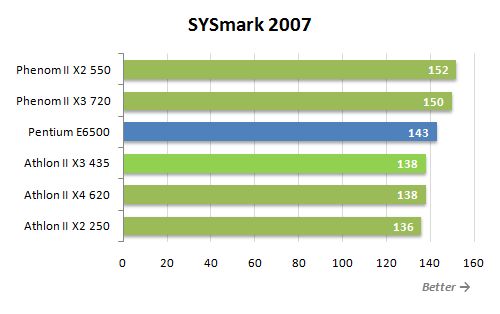
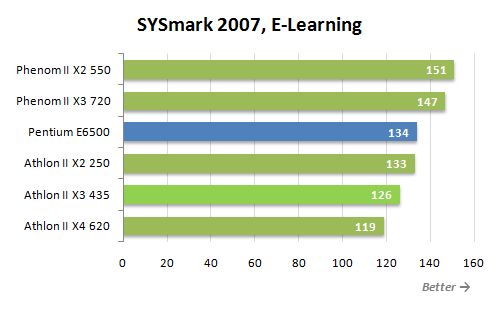
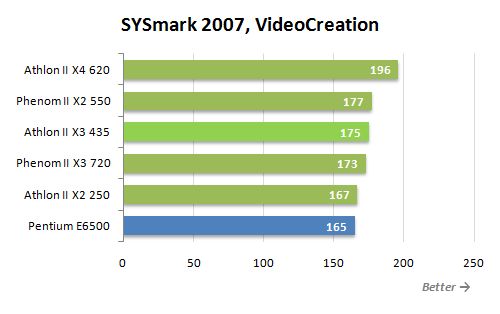
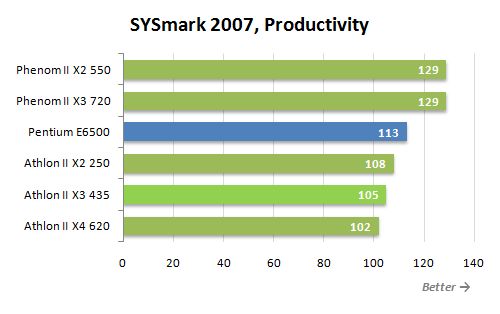
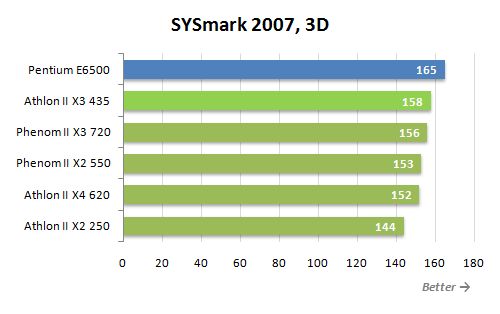
Frankly speaking, the results of SYSmark 2007 benchmark that estimate the average performance in general-purpose applications do not look too optimistic. On average, the new triple-core Athlon II X3 435 processor falls a little behind dual-core Intel Pentium E6500. It obviously happens because of relatively small cache memory of the newcomer: we clearly see that from the lag behind the Phenom II X3 720 working at a lower clock speed.
However, we shouldn’t regard the picture as too dramatic. Compared with other Athlon II processors, the new Athlon II X3 435 looks very good, running neck and neck even with the quad-core Athlon II X4 620. In other words, three cores are quite enough for most contemporary tasks. Especially in Windows 7 operating system, where the new task manager is way better optimized for multi-core architectures than in Windows Vista.
Gaming Performance
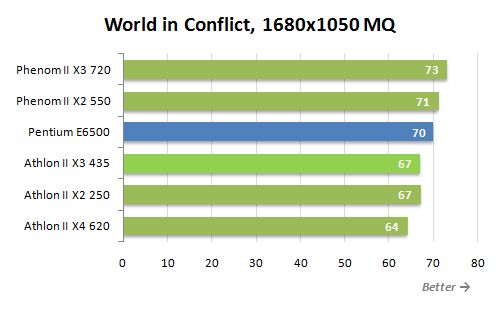
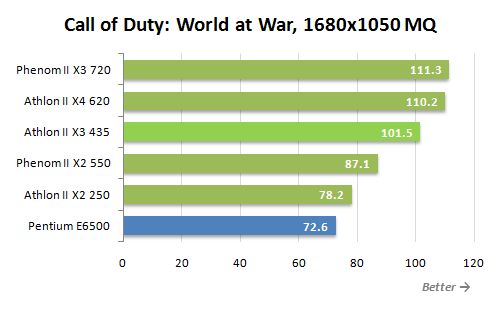
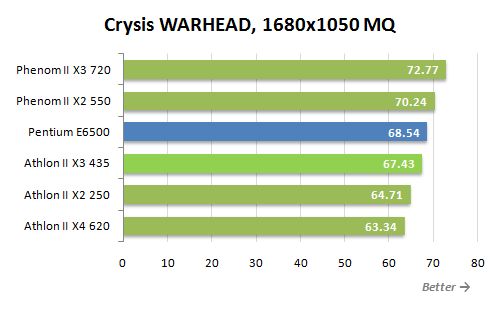
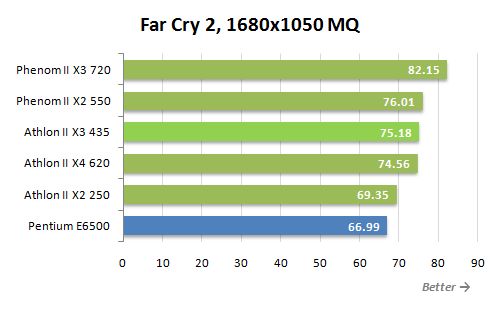
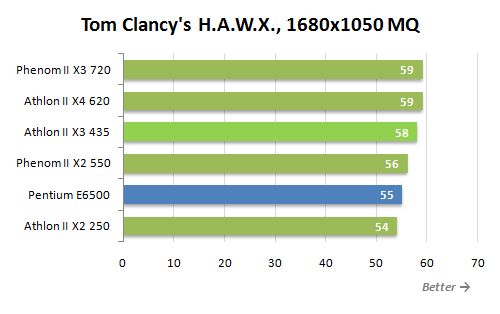
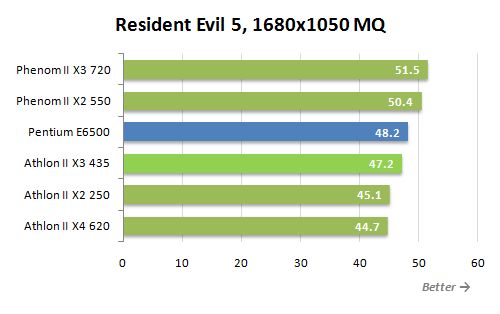
Gaming performance is one of the most important characteristics of mainstream processors. In this respect Athlon II 435 looks very convincing. Many contemporary games demonstrate a noticeable performance gain when the number of cores increases from two to three: therefore triple-core Athlon II X3 outperformed its dual-core counterpart in our today’s test session. As a result, the new Athlon II X3 435 turned out faster on average than the competing Pentium E6500 with only two computational cores. However, it is not very good that it has no L3 cache, because it determines the defeat not only by Phenom II X3 720, but sometimes also by Phenom II X2 550. Therefore, Phenom II processors still remain a preferable choice for gaming platform, although their higher price should also be taken into account.
Media Content Processing
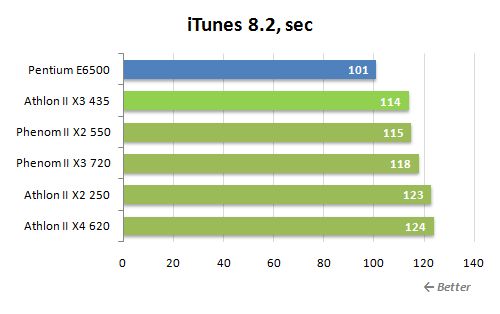
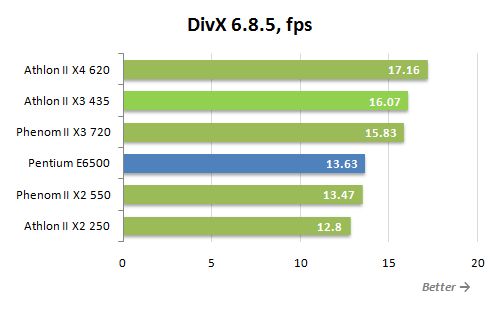
Audio and Video transcoding are very popular resource-hungry tasks that home computer systems often have to deal with. However, the developers of corresponding software applications always pay special attention to optimizing their solutions for multi-core CPUs. So, the results obtained here make a lot of sense. Triple-core processors work faster than dual-core ones, but lose to the quad-core ones. As a result, the new Athlon II X3 435 can easily outperform 90-dollar Intel processor, but at the same time loses to a 100-dollar quad-core Athlon II X4 620.
Applications Tests
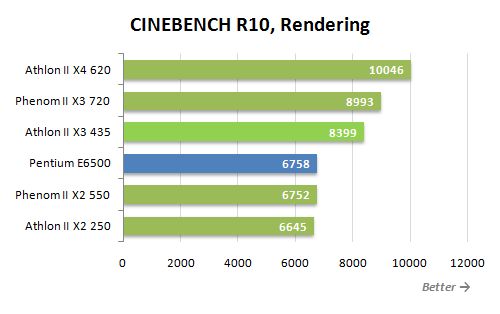
The number of computational cores is most crucial during final rendering that is why 25% advantage Athlon II X3 435 demonstrates over Pentium E6500 is not surprising at all.
The third core doesn’t matter too much in Mathematica 7 that is why Athlon II X3 435 can only boast taking down Athlon II X4 620, which most likely happened due to significantly higher clock frequency.
Like many other applications, Microsoft Excel belongs to those applications that can distribute the load efficiently over multiple computational cores. But in this case we see a very uncommon result: Athlon II X3 435 is convincingly ahead of dual-core Athlon II X2 250 and Phenom II X2 550, but at the same time loses to its dual-core direct competitor – Pentium E6500.
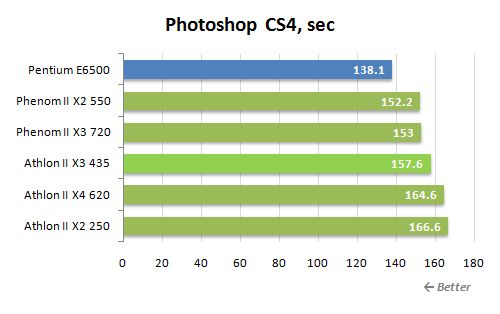
Adobe Photoshop is also way better optimized for Intel processors. Pentium E6500 outperforms AMD CPUs from the same price range no matter how many cores they’ve got.
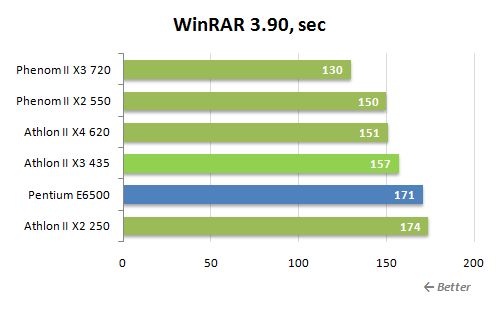
Archiving is sensitive to the amount of available cache memory that is why we see Phenom II solutions at the top of the diagram. However, Pentium E6500 also can’t boast a large cache that is why Athlon II X3 435 looks way better compared to it.
Power Consumption
The new AMD Athlon II X3 CPUs belong to the series of solutions with 95 W TDP. However, not only quad-core Athlon II X4, but also the majority of Phenom II X4 processors boasts the same thermal design power. It means that in reality the new processors should in fact consume less power because at least they have one less core. So what is the actual power consumption of the new Athlon II X3?
To answer this question we performed an additional separate test session. The following numbers show the total power consumption of the tested platforms (without the monitor). During our tests we used 64-bit LinX 0.6.3 utility to load the systems to the utmost extent. Moreover, to ensure that we estimate the power consumption in idle mode correctly we activated all power-saving technologies, such as C1E, Cool’nQuiet 3.0 and Enhanced Intel SpeedStep.
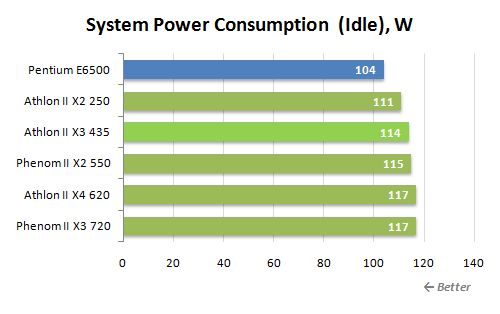
Unfortunately, Athlon II X3 435 based platform cannot compete against the one on Intel Pentium E6500 even in idle mode.
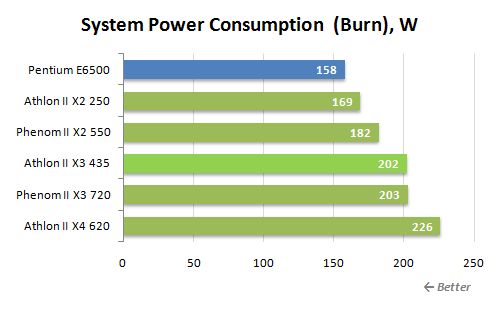
The situation during 100% CPU utilization is even less promising. Athlon II X3 435 based system loses over 40 W to the Intel platform. In other words, if you are planning to save some power, triple-core AMD processors are not the best way to go. Even AMD processors with two cores can offer much better performance-per-watt. However, if we take energy efficiency seriously, then we should probably pay more attention to a few other new AMD processors announced today: Athlon II e-series with 45 W maximum TDP.
Nevertheless, to get a better picture of the situation we also tested the power consumption of the Athlon II X3 435 processor under heavy load without taking into account the rest of the system components. To be more exact, we measured the power consumption along the 12 V power line connected directly to the processor voltage regulator on the mainboard and along the mainboard power lines.
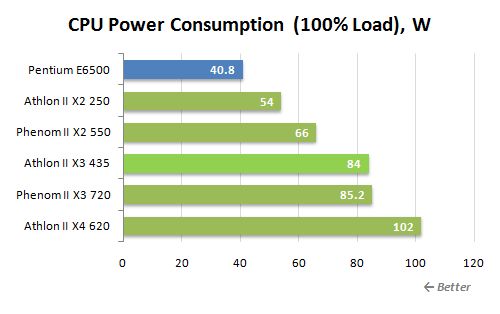
Athlon II X3 435 power consumption really doesn’t go as high as 95 W. But compared with Pentium E6500 its power consumption looks too high: the new AMD processor requires twice as much power, but in a significant number of tests performs slower than the competitor. This way, now that we have tested all the “standard” (meaning non-energy-efficient) AMD CPUs on 45 nm cores we have to conclude that all of them yield to Intel solutions in price-to-performance aspect. Unfortunately, the new Athlon II X3 didn’t turn things around here.
Conclusion
I believe no one will deny the fact that AMD is hopelessly behind Intel in microarchitecture development. K10 (Stars) microarchitecture that the company has been exploiting for the past several years doesn’t allow AMD to successfully compete against Intel in the upper market segment for a long time already. Therefore, the only way for AMD is to succeed in the lower market segment. Luckily, the development and production of Phenom II and Athlon II processors with 45 nm cores allowed AMD to lower the production costs of their solutions in time and make it possible for extremely affordable processors with more than two cores to appear in the market.
Not so long ago we reviewed a few of the first AMD solutions like that – Athlon II X4 quad-core processor family, with the junior models selling for no more than $100. These CPUs made a pretty good impression, especially in terms of price-to-performance. Today AMD went even further and announced even cheaper multi-core CPUs. Triple-core newcomers from Athlon II X3 series will be available for $70-$90.
Frankly speaking, Athlon II X3 are in a way unique processors because neither AMD nor Intel have any other solutions like that. Only these CPUs have more than two cores but at the same time are extremely affordable. These particular features will make Athlon II X3 a pretty demanded solution. Multi-threaded applications become more and more popular. Today even games may benefit from an extra processor core in your system, not to mention numerous programs for work with media content that are becoming wider spread among home users. In response to this tendency AMD decided to offer a suitable hardware platform at a democratic price.
So, Athlon II X3 processors look like a very good and, most importantly, timely solution, which we have every right to recommend to those users who work with resource-hungry software applications and value the advantages of multi-core architectures. Of course, new triple-core processors have a few drawbacks. They have relatively high power consumption and in some applications run even slower than the dual-core Intel CPUs with the same price point. But keeping in mind the uniqueness of Athlon II X3 CPUs, we can overlook these issues, especially since the new triple-core processors do boast a few hidden advantages, too. For example, they overclock very well and in some cases even allow unlocking the fourth core. In other words, Athlon II X3 is a great CPU for economical enthusiasts.